So your family just invested in a new piano – congratulations. How are you going to keep the keyboard looking and feeling brand new?
The keys are the one piece of the piano you touch every single time you sit down and play. Your fingers glide over the keys, touching not only the tops, but sometimes bumping into the sides as well. Even freshly washed hands can leave residue behind. Imagine what your child’s sticky fingers can do.
Is there anything special you need to know about cleaning piano keys the right way?
Let’s start with the basics.
You’ll need a soft cloth, water, and a gentle liquid soap.
While you can use a soft dish towel or cotton cloth, we recommend microfiber. They are soft and can be thrown into the laundry to reuse. Next, mix a solution of liquid soap and water in a spray bottle. You can reuse one – just make sure there aren’t any harsh chemical or solvent residue. Give the bottle a quick shake to mix, and you’re ready to clean.
The first rule is to never use water directly on the keys. Instead, lightly spray the cloth until it’s slightly damp. Then starting at one end of the keyboard and working a little at a time, slide the cloth across the keys applying a gentle pressure. You may need to repeat this a few times if a key has a stubborn spot.
Avoid wiping across the keyboard – instead, work front to back on each key. Working sideways can push tiny particles of dust between the keys, which can cause more problems down the road. If too much dust builds up between, it can create what is known as “sticky keys” where they won’t go down when you press them, or won’t return up when you release them.
Continue cleaning the piano keys in small groups from one side of the piano to the other. Once the tops of all the keys are clean, it’s time to look at the fronts. The small white squares in front can get dirty too.
Clean the fronts in the same manner, with gentle bottom to top movements. This way you may pull any dust that may have settled low onto the key up and off into the cloth. Pushing the cloth down or sideways can move dust particles between the keys, contributing to “sticky keys”.
If you have a new piano, the keys are made out of plastic, and you shouldn’t have any problems cleaning them. However, if your piano is old and still has ivory keys, you may want to use a light-colored cloth to avoid discoloration. Ivory can potentially absorb dye from dark or bright cleaning cloth. Otherwise, the cleaning solution from above will work just fine.


